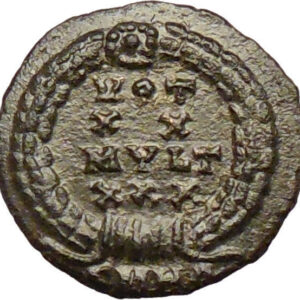|
Julia Mamaea – Augusta: 222-235 A.D.
Bronze 25mm (12.40 grams) of Anaazarbus in Cilicia. Dated CY 248, struck 229/230 A.D
Reference: Cf. RPC VI online 7350
Certification: NGC Ancients
Ch VF 6155926-010
ΙΟVΛ ΜΑΜAЄN СЄΒ, Draped bust right.
Rev: ANAZ MHT ЄNΔOΞ / B – Γ (retrograde) / ЄT HMC, Decastyle temple, with globus in pediment.
You are bidding on the exact item pictured, provided with a Certificate of Authenticity and Lifetime Guarantee of Authenticity.
Anazarbus was an ancient Cilician city. Under the late Roman Empire, it was the capital of Cilicia Secunda. It was destroyed in 1374. It was situated in Anatolia in modern Turkey, in the present Çukurova (or classical Aleian plain) about 15 km west of the main stream of the present Ceyhan River (or classical Pyramus river) and near its tributary the Sempas Su.
A lofty isolated ridge formed its acropolis. Though some of the masonry in the ruins is certainly pre-Roman, the Suda’s identification of it with Cyinda, famous as a treasure city in the wars of Eumenes of Cardia, cannot be accepted in the face of Strabo’s express location of Cyinda in western Cilicia.
It was founded by Assyrians. Under the early Roman Empire the place was known as Caesarea (Greek: Καισάρεια), and was the Metropolis (capital) of Late Roman province Cilicia Secunda. It was the home of the poet Oppian.
Rebuilt by the Eastern Roman emperor Justin I after an earthquake in the 6th century, it became Justinopolis (525); but the old native name persisted, and when Thoros I, king of Lesser Armenia, made it his capital early in the 12th century, it was known as Anazarva.
Julia Mamaea – Augusta: 222-235 A.D.
| Mother of Severus Alexander | Daughter of Julia Maesa | Mother-in-law of Orbiana | Sister of Julia Soaemias | Nice of Julia Domna and Septimius Severus | Aunt of Elagabalus | Cousin of Caracalla and Geta |

Julia Avita Mamaea (14 or 29 August after 180-235) was the second daughter of Julia Maesa, a powerful Roman woman of Syrian Arab origin and Syrian noble Julius Avitus. She was a niece of empress Julia Domna and emperor Septimius Severus and sister of Julia Soaemias. She was born and raised in Emesa (modern Homs, Syria).
Julia’s first husband was a former consul (whose name is unknown) who died. Julia married as her second husband Syrian Promagistrate Marcus Julius Gessius Marcianus. Julia bore Marcianus two children, a daughter called Theoclia (little is known of her) and a son, Marcus Julius Gessius Bassianus Alexianus, later emperor Alexander Severus. Unlike her sister, Julia Mamaea was reported to be a virtuous woman, never involved in scandals.
As a member of the Imperial Roman family, she watched closely the death of her cousin Caracalla and the ascent to power of her nephew Elagabalus, the oldest grandson of Julia Maesa and her choice to the throne. Eventually Elagabalus and his mother Julia Soaemias proved incompetent rulers and favour fell on Alexander, Julia’s son. He became emperor in 222, following Elagabalus’ murder by the Praetorian Guard. Julia and her mother became regents in the name of Alexander, then 14 years old. Upon adulthood, Alexander confirmed his esteem for his mother and named her consors imperii (imperial consort). It was in this condition that she accompanied her son in his campaigns: a custom started with Julia Domna. Thus she travelled to the East, for the campaign against Parthia and to the Germania provinces. Julia Mamaea was with Alexander in Moguntiacum (modern Mainz), capital of Germania Superior, when he was assassinated by his troops. She suffered the same fate.
|















